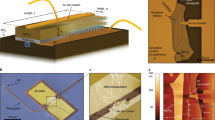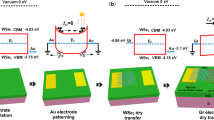Abstract
In integrated photonics, specific wavelengths such as 1,550 nm are preferred due to low-loss transmission and the availability of optical gain in this spectral region. For chip-based photodetectors, two-dimensional materials bear scientifically and technologically relevant properties such as electrostatic tunability and strong light–matter interactions. However, no efficient photodetector in the telecommunication C-band has been realized with two-dimensional transition metal dichalcogenide materials due to their large optical bandgaps. Here we demonstrate a MoTe2-based photodetector featuring a strong photoresponse (responsivity 0.5 A W–1) operating at 1,550 nm in silicon photonics enabled by strain engineering the two-dimensional material. Non-planarized waveguide structures show a bandgap modulation of 0.2 eV, resulting in a large photoresponse in an otherwise photoinactive medium when unstrained. Unlike graphene-based photodetectors that rely on a gapless band structure, this photodetector shows an approximately 100-fold reduction in dark current, enabling an efficient noise-equivalent power of 90 pW Hz–0.5. Such a strain-engineered integrated photodetector provides new opportunities for integrated optoelectronic systems.
This is a preview of subscription content, access via your institution
Access options
Access Nature and 54 other Nature Portfolio journals
Get Nature+, our best-value online-access subscription
$29.99 / 30 days
cancel any time
Subscribe to this journal
Receive 12 print issues and online access
$209.00 per year
only $17.42 per issue
Buy this article
- Purchase on Springer Link
- Instant access to full article PDF
Prices may be subject to local taxes which are calculated during checkout




Similar content being viewed by others
Data availability
The data that support the plots within this paper and other findings of this study are available from the corresponding author on reasonable request.
References
Jacobsen, R. S. et al. Strained silicon as a new electro-optic material. Nature 441, 199–202 (2006).
Cheng, T.-H. et al. Strain-enhanced photoluminescence from Ge direct transition. Appl. Phys. Lett. 96, 211108 (2010).
Feng, J., Qian, X., Huang, C.-W. & Li, J. Strain-engineered artificial atom as a broad-spectrum solar energy funnel. Nat. Photon. 6, 866–872 (2012).
Lee, M. L., Fitzgerald, E. A., Bulsara, M. T., Currie, M. T. & Lochtefeld, A. Strained Si, SiGe, and Ge channels for high-mobility metal-oxide-semiconductor field-effect transistors. J. Appl. Phys. 97, 11101 (2005).
Yun, W. S., Han, S. W., Hong, S. C., Kim, I. G. & Lee, J. D. Thickness and strain effects on electronic structures of transition metal dichalcogenides: 2H-MX 2 semiconductors (M = Mo, W; X = S, Se, Te). Phys. Rev. B 85, 1–5 (2012).
He, K., Poole, C., Mak, K. F. & Shan, J. Experimental demonstration of continuous electronic structure tuning via strain in atomically thin MoS2. Nano Lett. 13, 2931–2936 (2013).
Yue, Q. et al. Mechanical and electronic properties of monolayer MoS2 under elastic strain. Phys. Lett. A 376, 1166–1170 (2012).
Ghorbani-Asl, M., Borini, S., Kuc, A. & Heine, T. Strain-dependent modulation of conductivity in single-layer transition-metal dichalcogenides. Phys. Rev. B 87, 1–6 (2013).
Shi, H., Pan, H., Zhang, Y. W. & Yakobson, B. I. Quasiparticle band structures and optical properties of strained monolayer MoS2 and WS2. Phys. Rev. B 87, 1–8 (2013).
Manzeli, S., Allain, A., Ghadimi, A. & Kis, A. Piezoresistivity and strain-induced band gap tuning in atomically thin MoS2. Nano Lett. 15, 5330–5335 (2015).
Castellanos-Gomez, A. et al. Local strain engineering in atomically thin MoS2. Nano Lett. 13, 5361–5366 (2013).
Aslan, O. B. et al. Probing the optical properties and strain-tuning of ultrathin Mo1–xWxTe2. Nano Lett. 18, 2485–2491 (2018).
Eng, P. C., Song, S. & Ping, B. State-of-the-art photodetectors for optoelectronic integration at telecommunication wavelength. Nanophotonics 4, 277–302 (2015).
Feng, B. et al. All-Si photodetectors with a resonant cavity for near-infrared polarimetric detection. Nanoscale Res. Lett. 14, 39 (2019).
Walden, R. H. A review of recent progress in InP-based optoelectronic integrated circuit receiver front-ends. In GaAs IC Symposium IEEE Gallium Arsenide Integrated Circuit Symposium. 18th Annual Technical Digest 255–257 (IEEE, 1996).
Narayana, V. K., Sun, S., Badawy, A.-H., Sorger, V. J. & El-Ghazawi, T. MorphoNoC: exploring the design space of a configurable hybrid NoC using nanophotonics. Microprocess. Microsyst. 50, 113–126 (2017).
Liu, K., Sun, S., Majumdar, A. & Sorger, V. J. Fundamental scaling laws in nanophotonics. Sci. Rep. 6, 37419 (2016).
Michel, J., Liu, J. & Kimerling, L. C. High-performance Ge-on-Si photodetectors. Nat. Photon. 4, 527 (2010).
Goykhman, I., Desiatov, B., Khurgin, J., Shappir, J. & Levy, U. Waveguide based compact silicon Schottky photodetector with enhanced responsivity in the telecom spectral band. Opt. Express 20, 28594 (2012).
Wang, J. & Lee, S. Ge-photodetectors for Si-based optoelectronic integration. Sensors 11, 696–718 (2011).
Youngblood, N., Chen, C., Koester, S. J. & Li, M. Waveguide-integrated black phosphorus photodetector with high responsivity and low dark current. Nat. Photon. 9, 247–252 (2015).
Bie, Y. Q. et al. A MoTe2-based light-emitting diode and photodetector for silicon photonic integrated circuits. Nat. Nanotechnol. 12, 1124–1129 (2017).
Octon, T. J., Nagareddy, V. K., Russo, S., Craciun, M. F. & Wright, C. D. Fast high-responsivity few-layer MoTe2 photodetectors. Adv. Opt. Mater. 4, 1750–1754 (2016).
Youngblood, N., & Li, Mo. Integration of 2D materials on a silicon photonics platform for optoelectronics applications. Nanophotonics 6, 1205 (2017).
Ma, P. et al. Fast MoTe2 waveguide photodetector with high sensitivity at telecommunication wavelengths. ACS Photonics 5, 1846–1852 (2018).
Gan, X. et al. Chip-integrated ultrafast graphene photodetector with high responsivity. Nat. Photon. 7, 883–887 (2013).
Schuler, S. et al. Controlled generation of a p–n junction in a waveguide integrated graphene photodetector. Nano Lett. 16, 7107–7112 (2016).
Island, J. O., Steele, G. A., van der Zant, H. S. J. & Castellanos-Gomez, A. Environmental instability of few-layer black phosphorus. 2D Mater. 2, 11002 (2015).
Deng, S., Sumant, A. V. & Berry, V. Strain engineering in two-dimensional nanomaterials beyond graphene. Nano Today 22, 14–35 (2018).
Johari, P. & Shenoy, V. B. Tuning the electronic properties of semiconducting transition metal dichalcogenides by applying mechanical strains. ACS Nano 6, 5449–5456 (2012).
Keum, D. H. et al. Bandgap opening in few-layered monoclinic MoTe2. Nat. Phys. 11, 482–486 (2015).
Shiue, R.-J. et al. High-responsivity graphene–boron nitride photodetector and autocorrelator in a silicon photonic integrated circuit. Nano Lett. 15, 7288–7293 (2015).
Hemnani, R. A. et al. Towards a 2D printer: a deterministic cross contamination-free transfer method for atomically layered material. 2D Mater 6, 015006 (2018).
Li, H. et al. Optoelectronic crystal of artificial atoms in strain-textured molybdenum disulphide. Nat. Commun. 6, 7381 (2015).
Conley, H. J. et al. Bandgap engineering of strained monolayer and bilayer MoS2. Nano Lett. 13, 3626–3630 (2013).
Frisenda, R. et al. Biaxial strain tuning of the optical properties of single-layer transition metal dichalcogenides, npj 2D Mater. Appl. 1, 10 (2017).
Desai, S. B. et al. Strain-induced indirect to direct bandgap transition in multilayer WSe2. Nano Lett. 14, 4592–4597 (2014).
Melitz, W., Shen, J., Kummel, A. C. & Lee, S. Surface science reports kelvin probe force microscopy and its application. Surf. Sci. Rep. 66, 1–27 (2011).
Sarwat, S. G. et al. Revealing strain-induced effects in ultrathin heterostructures at the nanoscale. Nano Lett. 18, 2467–2474 (2018).
Jung, D. Y., Yang, S. Y., Park, H., Shin, W. C., Oh, J. G., Cho, B. J. & Choi, S.-Y. Interface engineering for high performance graphene electronic devices. Nano Converg. 2, 11 (2015).
Meng, L. et al. Two-dimensional WS2 lateral heterojunctions by strain modulation. Appl. Phys. Lett. 108, 263104 (2016).
Casalino, M. et al. Vertically illuminated, resonant cavity enhanced, graphene–silicon Schottky photodetectors. ACS Nano 11, 10955–10963 (2017).
Huang, L. et al. Waveguide-integrated black phosphorus photodetector for mid-infrared applications. ACS Nano 13, 913–921 (2019).
Kresse, G. & Furthmüller, J. Efficient iterative schemes for ab initio total-energy calculations using a plane-wave basis set. Phys. Rev. B 54, 11169–11186 (1996).
Perdew, J. P., Burke, K. & Ernzerhof, M. Generalized gradient approximation made simple. Phys. Rev. Lett. 77, 3865–3868 (1996).
Paier, J. et al. Screened hybrid density functionals applied to solids. J. Chem. Phys. 124, 154709 (2006).
Pack, J. D. & Monkhorst, H. J. “Special points for Brillouin-zone integrations”—a reply. Phys. Rev. B 16, 1748–1749 (1977).
Plimpton, S. Fast parallel algorithms for short-range molecular dynamics. J. Comput. Phys. 117, 1–19 (1995).
Stillinger, F. H. & Weber, T. A. Computer simulation of local order in condensed phases of silicon. Phys. Rev. B 31, 5262–5271 (1985).
Jiang, J.-W. & Zhou, Y.-P. in Handbook of Stillinger–Weber Potential Parameters for Two-Dimensional Atomic Crystals (InTech, 2017).
Ichimura, M. Stillinger–Weber potentials for III–V compound semiconductors and their application to the critical thickness calculation for InAs/GaAs. Phys. Status solidi 153, 431–437 (1996).
Zhou, Y.-P. & Jiang, J.-W. Molecular dynamics simulations for mechanical properties of borophene: parameterization of valence force field model and Stillinger-Weber potential. Sci. Rep. 7, 45516 (2017).
Acknowledgements
V.J.S. is supported by AFOSR (grant no. FA9550-17-1-0377) and ARO (grant no. W911NF-16-2-0194). M.A.S.R.S., B.U. and S.D.S. acknowledge support from the US Department of Energy, Office of Science, Basic Energy Sciences under award no. DE-SC0018041. S.R.B. acknowledges support from NSF grant nos. DMR-1839175 and CCF-1838435. We acknowledge computational support from the Minnesota Supercomputing Institute (MSI).
Author information
Authors and Affiliations
Contributions
R.M. and V.J.S. initiated the project and conceived the experiments. C.P. and T.X. fabricated the devices. R.M. and M.A.S.R.S. performed the measurements and data analysis. B.U., S.D.S., J.G.A., T.L., M.M. and R. Amin provided modelling and the theoretical analysis. A.F.B. and S.R.B. performed supporting experiments. D.V.T. provided planarized photonic chip. R.M and V.J.S. co-wrote the manuscript, and R. Agarwal provided suggestions throughout the project. All authors discussed and commented on the manuscript.
Corresponding author
Ethics declarations
Competing interests
The authors declare no competing interests
Additional information
Publisher’s note Springer Nature remains neutral with regard to jurisdictional claims in published maps and institutional affiliations.
Supplementary information
Supplementary Information
Supplementary Figs. 1–14, discussions and Table 1.
Rights and permissions
About this article
Cite this article
Maiti, R., Patil, C., Saadi, M.A.S.R. et al. Strain-engineered high-responsivity MoTe2 photodetector for silicon photonic integrated circuits. Nat. Photonics 14, 578–584 (2020). https://doi.org/10.1038/s41566-020-0647-4
Received:
Accepted:
Published:
Issue Date:
DOI: https://doi.org/10.1038/s41566-020-0647-4
This article is cited by
-
Nanoimprint-induced strain engineering of two-dimensional materials
Microsystems & Nanoengineering (2024)
-
Photogating-assisted tunneling boosts the responsivity and speed of heterogeneous WSe2/Ta2NiSe5 photodetectors
Nature Communications (2024)
-
Electro-optic tuning in composite silicon photonics based on ferroionic 2D materials
Light: Science & Applications (2024)
-
In-situ fabrication of on-chip 1T’-MoTe2/Ge Schottky junction photodetector for self-powered broadband infrared imaging and position sensing
Nano Research (2024)
-
High performance photodetector based on few-layer MoTe2/CdS0.42Se0.58 flake heterojunction
Frontiers of Physics (2024)



